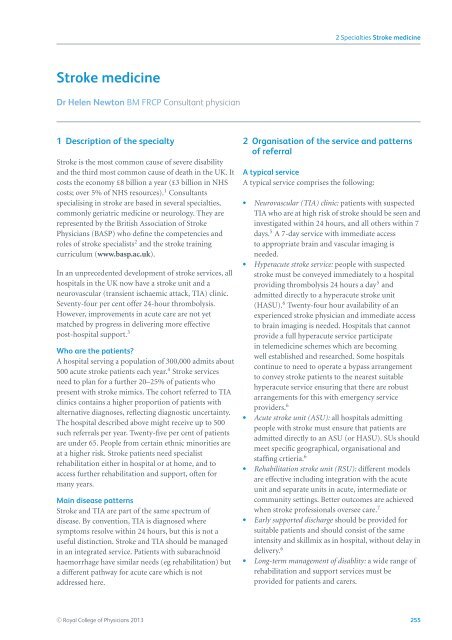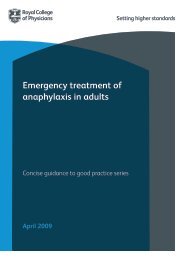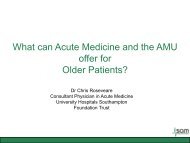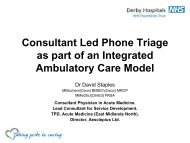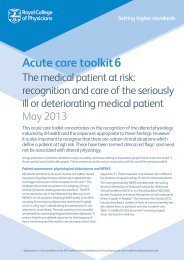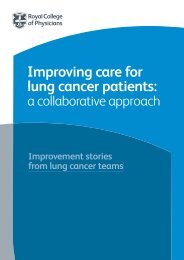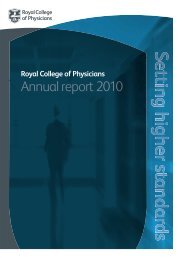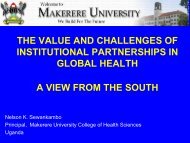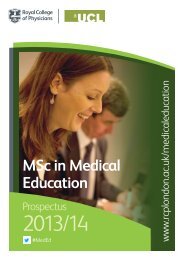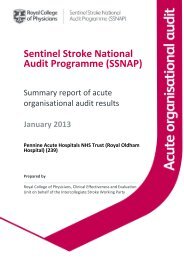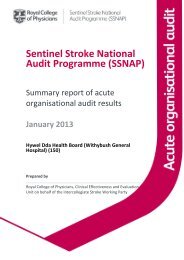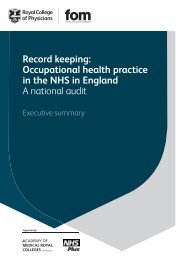Consultant physicians working with patients - Royal College of ...
Consultant physicians working with patients - Royal College of ...
Consultant physicians working with patients - Royal College of ...
You also want an ePaper? Increase the reach of your titles
YUMPU automatically turns print PDFs into web optimized ePapers that Google loves.
2 Specialties Stroke medicineStroke medicineDr Helen Newton BM FRCP <strong>Consultant</strong> physician1 Description <strong>of</strong> the specialtyStroke is the most common cause <strong>of</strong> severe disabilityand the third most common cause <strong>of</strong> death in the UK. Itcosts the economy £8 billion a year (£3 billion in NHScosts; over 5% <strong>of</strong> NHS resources). 1 <strong>Consultant</strong>sspecialising in stroke are based in several specialties,commonly geriatric medicine or neurology. They arerepresented by the British Association <strong>of</strong> StrokePhysicians (BASP) who define the competencies androles <strong>of</strong> stroke specialists 2 and the stroke trainingcurriculum (www.basp.ac.uk).In an unprecedented development <strong>of</strong> stroke services, allhospitals in the UK now have a stroke unit and aneurovascular (transient ischaemic attack, TIA) clinic.Seventy-four per cent <strong>of</strong>fer 24-hour thrombolysis.However, improvements in acute care are not yetmatched by progress in delivering more effectivepost-hospital support. 3Who are the <strong>patients</strong>?A hospital serving a population <strong>of</strong> 300,000 admits about500 acute stroke <strong>patients</strong> each year. 4 Stroke servicesneed to plan for a further 20–25% <strong>of</strong> <strong>patients</strong> whopresent<strong>with</strong>strokemimics.ThecohortreferredtoTIAclinics contains a higher proportion <strong>of</strong> <strong>patients</strong> <strong>with</strong>alternative diagnoses, reflecting diagnostic uncertainty.The hospital described above might receive up to 500such referrals per year. Twenty-five per cent <strong>of</strong> <strong>patients</strong>are under 65. People from certain ethnic minorities areat a higher risk. Stroke <strong>patients</strong> need specialistrehabilitation either in hospital or at home, and toaccess further rehabilitation and support, <strong>of</strong>ten formany years.Main disease patternsStroke and TIA are part <strong>of</strong> the same spectrum <strong>of</strong>disease. By convention, TIA is diagnosed wheresymptoms resolve <strong>with</strong>in 24 hours, but this is not auseful distinction. Stroke and TIA should be managedin an integrated service. Patients <strong>with</strong> subarachnoidhaemorrhage have similar needs (eg rehabilitation) buta different pathway for acute care which is notaddressed here.2 Organisation <strong>of</strong> the service and patterns<strong>of</strong> referralA typical serviceA typical service comprises the following: Neurovascular (TIA) clinic: <strong>patients</strong> <strong>with</strong> suspectedTIAwhoareathighrisk<strong>of</strong>strokeshouldbeseenandinvestigated <strong>with</strong>in 24 hours, and all others <strong>with</strong>in 7days. 5 A 7-day service <strong>with</strong> immediate accessto appropriate brain and vascular imaging isneeded. Hyperacute stroke service: people <strong>with</strong> suspectedstroke must be conveyed immediately to a hospitalproviding thrombolysis 24 hours a day 5 andadmitted directly to a hyperacute stroke unit(HASU). 6 Twenty-four hour availability <strong>of</strong> anexperienced stroke physician and immediate accessto brain imaging is needed. Hospitals that cannotprovide a full hyperacute service participatein telemedicine schemes which are becomingwell established and researched. Some hospitalscontinue to need to operate a bypass arrangementto convey stroke <strong>patients</strong> to the nearest suitablehyperacute service ensuring that there are robustarrangements for this <strong>with</strong> emergency serviceproviders. 6 Acutestrokeunit(ASU):all hospitals admittingpeople <strong>with</strong> stroke must ensure that <strong>patients</strong> areadmitted directly to an ASU (or HASU). SUs shouldmeet specific geographical, organisational andstaffing crtieria. 6 Rehabilitation stroke unit (RSU): different modelsare effective including integration <strong>with</strong> the acuteunit and separate units in acute, intermediate orcommunity settings. Better outcomes are achievedwhen stroke pr<strong>of</strong>essionals oversee care. 7 Early supported discharge should be provided forsuitable <strong>patients</strong> and should consist <strong>of</strong> the sameintensity and skillmix as in hospital, <strong>with</strong>out delay indelivery. 6 Long-term management <strong>of</strong> disablity: awiderange<strong>of</strong>rehabilitation and support services must beprovided for <strong>patients</strong> and carers.C○ <strong>Royal</strong> <strong>College</strong> <strong>of</strong> Physicians 2013 255


